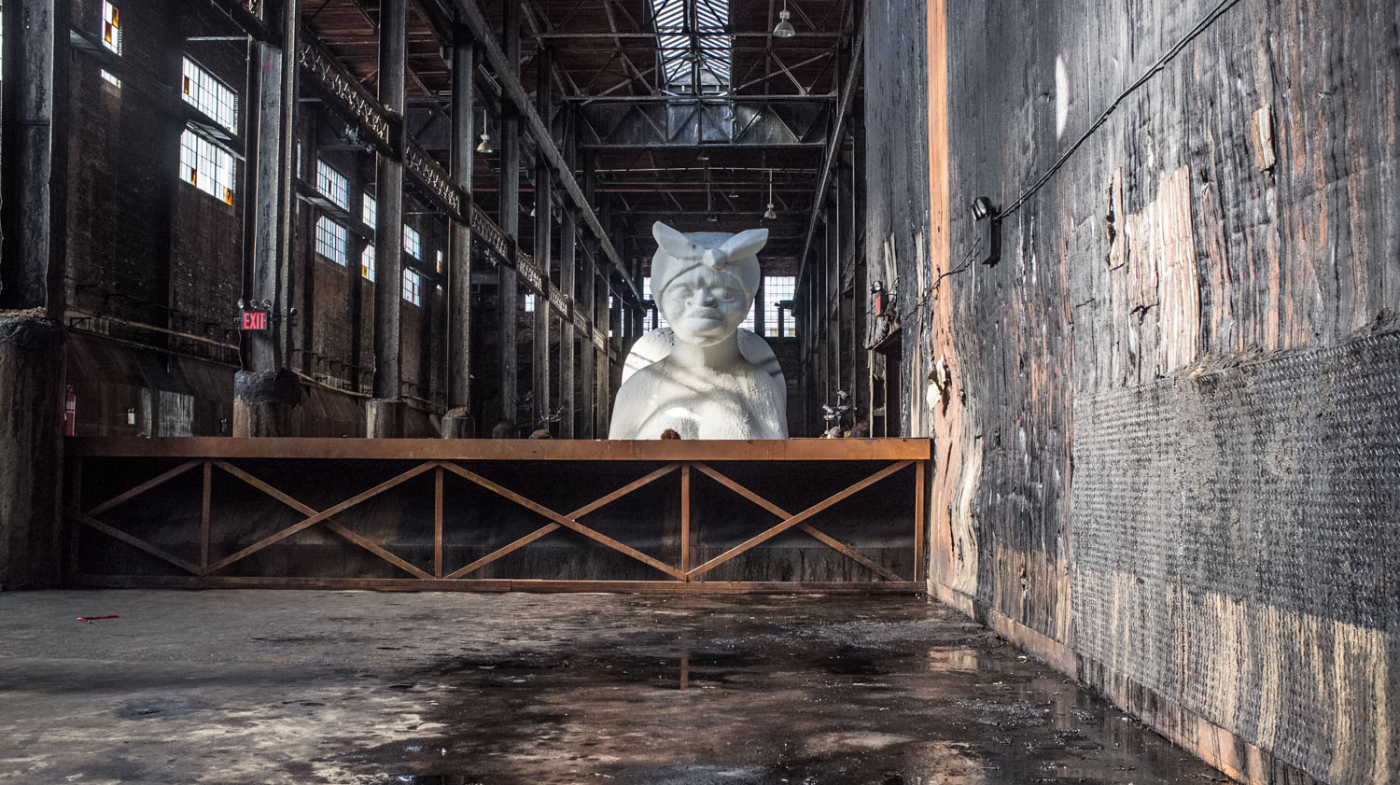
The Marvelous Sugar Baby
Kara E. Walker and Creative Time are behind what may by the most dramatic and thrilling site specific art installation of the 21st century

Kara E. Walker and Creative Time are behind what may by the most dramatic and thrilling site specific art installation of the 21st century

4,000 people turned up for the opening, the queue was averaging two hours on spring weekends and it’s all that New Yorkers have been able to talk about for months.
“Have you seen the Sugar Baby!?”
Artist Kara E. Walker’s monumental installation in Brooklyn, produced in association with Creative Time, was scheduled to close in early May, but we’re delighted that the Marvelous Sugar Baby is going to remain on view through to 6th July.
If you see one thing in the city this summer, this should be it – even though it’s only open from Friday afternoon through to Sunday evening, and the East River Ferry is packed with people heading in the same direction. And yes, you’ll be waiting up to an hour to get in (tended to by industrious ice cream sellers, working the epic queue).

The Marvelous Sugar Baby
The full name of this site-specific installation is emblazoned in elegant script on the decadent front of the abandoned Domino Sugar factory: At the behest of Creative Time Kara E. Walker has confected: Kara Walker – A Subtlety or the Marvelous Sugar Baby an Homage to the unpaid and overworked Artisans who have refined our Sweet tastes from the cane fields to the Kitchens of the New World on the Occasion of the demolition of the Domino Sugar Refining Plant.
The phrase “A Subtlety” refers to the sugar sculptures that were the centerpieces for medieval feasts. But there’s nothing subtle about this work – and it’s all the better for it. The Marvelous Sugar Baby is truly amazing.

The Marvelous Sugar Baby
It would be a thrill in itself just to access this landmark building on the banks of Williamsburg on the East River: every inch of its cavernous, industrial, ghostly interior is rich with a palimpsest of rust and molasses. To see it used for such an extravagant, poignant and immersive project is tremendous.
The main Sugar Baby herself is a 35 foot high and 75 foot long black plantation worker presented in the fashion of a giant white sugar sphinx, kneeling on all fours. The sculpture isn’t, in fact, pure sugar, but is fashioned from 330 foam blocks, carved to fit together by Digital Atelier, and pieced together on site before being covered with 35 tons of white sugar. Artist Walker created the face of the Sugar Baby in her own image.
Surrounding the Baby are smaller “Blackamoor” sculptures of boys bearing baskets, sculpted from molasses and brown sugar. Each figure is in a state of decay, mouldering, shattering, dissolving day by day, standing in a pool of its own substance.

The Domino Sugar Factory
One of the most asked questions about the installation is why it isn’t besieged by wasps, ants and vermin. Apparently it’s down to the nature of the warehouse’s construction and the fact that it’s been empty for years. That, and the fact that Two Trees, the powerhouse development company (responsible for the nearby Wythe Hotel, and just about everything else in “The New Brooklyn”), who are taking the space over to build condos, began spraying the site to safeguard against pests last year.
The walls are covered with dark molasses, creating the most incredible visual patina of black and bronze and crystal, as if scorched and melting all at once
The Marvelous Sugar Baby is a powerful, moving, exhilarating comment on the underpaid and the exploited. It’s a truly immersive experience: the first thing that hits you when you walk into old Domino Sugar Refinery is the intoxicating smell of… sugar. The walls are covered with dark molasses, creating the most incredible visual patina of black and bronze and crystal, as if scorched and melting all at once. The aroma hits your lungs with force. It’s unlike anything you will have experienced before. Once you’ve got over the smell, you make out the vast white sculpture, looming ahead of you, flanked by rough dark walls and caged in with black steel girders.
Artist Walker was partially inspired by a 1920s monument approved by Senate to memorialize “the faithful slave mammies of the South”.
The Sugar Baby is a beautiful but melancholy experience. Matters of slave and child labour practices and fare wages aside, it’s also sad that this incredible building will soon disappear, to make way for yet more luxury apartments in a once thriving industrial area of New York. C